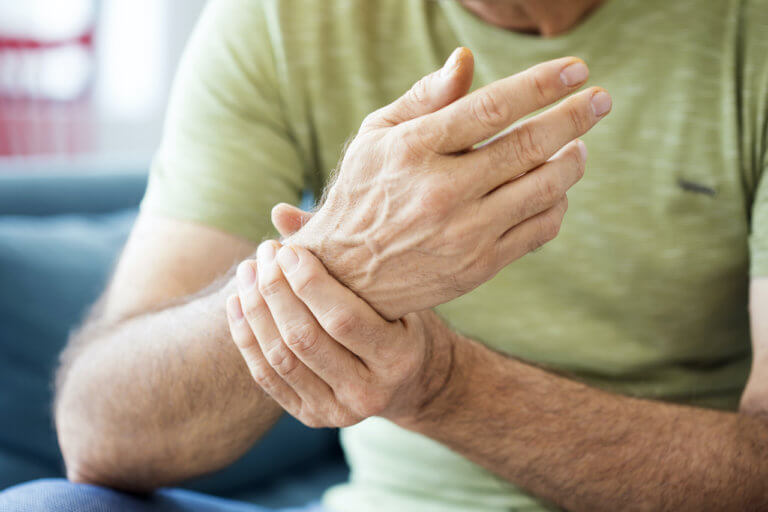Our Natural, Safe, and Non-Invasive Methods Can Help You Move With Ease
If you have arthritis, then you know all about the difficulties with moving and functioning in daily life that it can present. What you might not know, however, is that occupational therapy can help you find relief from your arthritis pain.
There is no cure for arthritis, but by using the exercises and techniques that your occupational therapist can teach you, the onset of arthritis can be slowed and you will experience less pain overall.
You have the choice for a safer, more effective path toward arthritis pain management: occupational therapy. Contact Hand in Hand Rehabilitation and schedule an occupational therapy appointment today.
What are the main benefits of occupational therapy for arthritis pain?
Arthritis attacks the joints of the body, including your hands, so the goal of occupational therapy will be to restore the use of those joints and improve your ability to move around and engage in daily activities.
This will be achieved through a combination of exercise to strengthen the support structures around the joints, and teaching you how to move and engage in activities without worsening your symptoms. The exact course of treatment that your occupational therapist will prescribe will depend on how advanced your arthritis is and which parts of the body are impacted.
The exercises your therapist will teach you will be directed toward improving your mobility, range of motion, flexibility, and coordination. Your plan may include any combination of:
- Posture: Your therapist will teach you various body mechanic techniques that will improve joint function and reduce pain. You will also be taught ways to use your strongest muscles and joints to relieve pressure on arthritic joints.
- Treatments: Modern occupational therapy has a broad range of treatment options available to assist with arthritis pain. Hot and cold therapy can relieve the pain and stiffness in joints; braces or splints can help to stabilize and support arthritic joints; shoe inserts can relieve arthritis pain in the lower extremities; and so on.
- Environmental modifications: Your occupational therapist can make specific recommendations for additional therapeutic aids based on your type of arthritis. These can include ergonomic furniture or cushioned mats in areas of your home or at work where you tend to stand on your feet for long periods of time.
The two most common types of arthritis
Arthritis includes an entire family of painful joint conditions. For some individuals, it may take the form of painful gout in a toe joint; in others, it can strike due to a bacterial joint infection. The majority of arthritis sufferers, however, suffer from one of two agonizing conditions:
- Rheumatoid arthritis – This form of arthritis is caused by an auto-immune disease or dysfunction. The same protective mechanisms that normally fight off disease germs decide to turn on your joints, treating them as the enemy and attacking them. This results in painful inflammation that may come and go, leaving joint swelling and deformity in its wake.
- Osteoarthritis – This most common form of arthritis is usually a natural consequence of a lifetime of joint motion, coupled with certain changes that take place during aging. Healthy joints contain not only a lubricating fluid to keep the bone ends moving smoothly, but also a layer of cartilage that acts as a shock absorber and anti-friction component. Over time, however, the production of lubricating fluid can start to dry up, while the cartilage becomes thinner and more worn until it finally breaks down completely. This leaves you with pain, stiffness, and inflammation that usually feels worse whenever you try to move or put weight on the joint.
What will my occupational therapy sessions look like?
Occupational therapy visits are often short in duration. Your therapist will be focused on spotting problems with your physical function that are related to arthritis, and teaching you methods you can employ at home to relieve pain.
The way to actually achieve pain relief from your arthritis is to keep up with the teachings for the long term. The improvement will be gradual, so it’s important that you follow your occupational therapist’s instructions.
In order to help your occupational therapist to provide you with the best advice possible, think carefully about different physical goals that you might have.
For example, you might want to be able to do your daily job without straining your shoulder or wrist, to reach things high up on a kitchen shelf, or to simply get in and out of your car without pain. Expressing these goals to your therapist will aid in ensuring that your treatments are as specific to your goals as possible.
Your occupational therapy sessions probably won’t need to be done on a weekly basis. Once every few weeks to monitor your condition and progress should be sufficient.
Ready to get started?
If you are ready for relief from arthritis pain, contact Hand in Hand Rehabilitation to schedule your first appointment with an occupational therapist.



